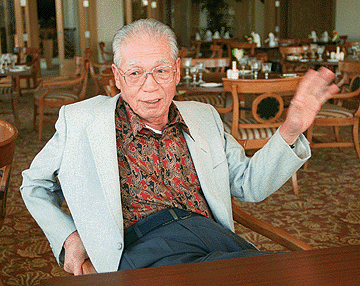
Photo by Craig T. Kojima, Star-Bulletin
Masakuni Osano, president and CEO of Kyo-ya Co., sits in the
Coral Reef Restaurant at the recently renovated Sheraton Maui
resort as he talks about the company's long history in Hawaii.

As the oldest Japanese investor in Hawaii hotels, Kyo-ya did its buying before the bubble drove up prices and was unfazed while other Japanese investors came and went, says Masakuni Osano, president and chief executive officer of the company and its big parent in Japan, Kokusai Kogyo Co.
Kyo-ya didn't have to sell any properties at fire sale prices to pay huge loans, as did those who bought at inflated prices and saw their investments fall in value.
In fact, Osano said in a relaxed interview at Kyo-ya's rebuilt Sheraton Maui last week, the company has easily been able to hold to its long-term policy of simply not selling any of the hotels it owns.
"Because of the bubble, a lot of Japanese companies left Hawaii," Osano said through an interpreter. "Our company has been here 33, 34 years. We're not in the same situation as the 'bubble' investors," he said.
Osano, 68, runs a vast commercial empire as president of Kokusai Kogyo, owner of billions of dollars worth of commercial properties, residential real estate, transportation and other interests in Japan and around the world.
The Kyo-ya part - which started when Osano's brother, the late Kenji Osano, opened the Kyo-ya Restaurant on Kalakaua Avenue in 1956 as the company's first Hawaii investment - operates several dozen hospitality units.
Most are in Japan but the company also owns the four Sheraton-managed hotels in Waikiki and the Sheraton Maui, the Sheraton Palace in San Francisco, the Grand Cypress Hotel in Orlando, Fla., and the Renaissance in Sydney, Australia.
By today's standards, the company's Hawaii acquisitions were for peanuts. Kyo-ya spent less than $200 million to buy all its Hawaii properties, including the cost of building new towers at two Waikiki properties.
Even its biggest single purchase, the 1974 acquisition of the Royal Hawaiian Hotel, the Sheraton Waikiki and the Sheraton Maui as a group, was for $104 million. Later Japanese investors were to pay $200 million, $300 million and more for individual Hawaii hotels.
As its Hawaii properties soared in value and the cash flow increased, Kyo-ya maintained a policy of putting the money back into hotel improvements, Osano said.
The Waikiki hotels alone have a capital improvement budget of $25 million a year.
Kyo-ya was able to spend $50 million on the 1989 renovation of the Sheraton Moana and over the last two years, $160 million to redevelop the Sheraton Maui.
Osano said he has faith in Hawaii tourism, yet he does believe some actions can be taken to make the tourism outlook more positive.
For example, although Japanese arrivals now are processed efficiently at Hawaii's airports, there could be a bit more aloha spirit in the process, he said.
"Tourists come here for fun. Why do they have to be asked, how much are you bringing in with you? What do you possess? If the government can treat people easier it would be better."
While Osano pointed out that his company's hotels in Hawaii don't depend entirely on the Japanese, who make up about 40 percent of the business at the Waikiki hotels and 30 percent on Maui, it is still an important market.
Asked how he would turn around the Japanese trend to shorter stays in Hawaii and get them to stay longer, Osano shrugged. "Japanese nationals are always in a hurry," he said. But he added that the development of a convention center in Honolulu and the increased convention space at the Sheraton Maui should encourage business travelers, who tend to stay longer.
Meanwhile the Japanese continue to flock overseas. "Eight years ago the Japanese government launched a campaign to get 10 million people traveling a broad each year within 10 years. The annual number of tourists going to foreign countries is already 16 million," Osano said.
"Now there's so much overseas travel that they're trying to get something done to boost domestic tourism," he said.
Osano is a member of a prestigious tourism policy committee that advises the Japanese government. "We have been making suggestions to the government on how to boost tourism, but they're not getting into the high mood. There's no 'let's do it,'" he said.
Some Hawaii investments by Kyo-ya Co. and its parent company Kokusai Kogyo Co.:
1956 - Opened Kyo-ya Restaurant.
1963 - Bought Princess Kaiulani Hotel, $8.7 million; and Moana & Surfrider Hotels, $10.7 million
1969 - Opened new Surfrider, cost $10 million
1970 - Opened Princess Kaiulani tower, $13 million.
1974 - Bought Royal Hawaiian, Sheraton Waikiki & Sheraton Maui, $104 million.
1989 - Moana Hotel renovation, $50 million
1991 - Kyo-ya Restaurant renovation, $15 million.
1996 - Sheraton Maui redevelopment, $160 million.